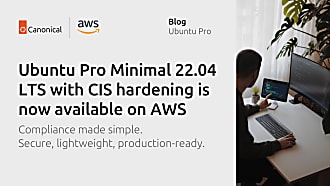Canonical
on 6 May 2015

There has been a lot of interest on the various mailing lists as well as internally at Canonical about the state of migration in LXD, so I thought I’d write a bit about the current state of affairs.
Migration in LXD today passes the “Doom demo” test, i.e. it works well enough to reproduce the LXD announcement demo under certain conditions, which I’ll cover below. There is still a lot of ongoing work to make CRIU (the underlying migration technology) work with all these configurations, so support will eventually arrive for everything. For now, though, you’ll need to use the configuration I describe below.
First, I should note that things currently won’t work on a systemd host. Since systemd re-mounts the rootfs as MS_SHARED, lots of things automatically become shared mounts, which confuses CRIU. There are several mailing list threads about ongoing work with respect to shared mounts in CRIU and I expect something to be merged that will resolve the situation shortly, but for now your host machine needs to be a non-systemd host (i.e. trusty or utopic will work just fine, but not vivid).
You’ll need to install the daily versions of liblxc and lxd from their respective PPAs on each host:
sudo apt-add-repository -y ppa:ubuntu-lxc/daily
sudo apt-add-repository -y ppa:ubuntu-lxc/lxd-git-master
sudo apt-get update
sudo apt-get install lxdAlso, you’ll need to uninstall lxcfs on both hosts:
sudo apt-get remove lxcfsliblxc currently doesn’t support migrating the mount configuration that lxcfs uses, although there is some work on that as well. The overmounting issue has been fixed in lxcfs, so I expect to land some patches in liblxc soon that will make lxcfs work.
Next, you’ll want to set a password for your new lxd instance:
lxc config set password fooYou need some images in lxd, which can be acquired easily enough by lxd-images (of course, this only needs to be done on the source host of the migration):
lxd-images import lxc ubuntu trusty amd64 --alias ubuntuwhich will then allow you to create a container to migrate:
lxc init ubuntu migrateeLastly, you’ll also need to set a few configuration items in lxd. First, the container needs to be privileged, although there is yet more ongoing work to remove this restriction. There are also a few things that CRIU does not support, so we need to set our container config to respect those as well. You can do all of this using lxd’s profiles mechanism, that is:
lxc config profile create migratable
lxc config profile edit migratableAnd paste the following content in instead of what’s there:
ame: migratable
config:
raw.lxc: |
lxc.console = none
lxc.cgroup.devices.deny = c 5:1 rwm
lxc.start.auto =
lxc.start.auto = proc:mixed sys:mixed
security.privileged: "true"
devices: {}And apply the profile to your container:
lxc config profile apply migratee migratableFinally, add both of your LXDs as non unix-socket remotes (required for now, but not forever):
lxc remote add lxd thishost:8443 # don't use localhost here
lxc remote add lxd2 otherhost:8443 # use a publicly addressable nameProfiles used by a particular container need to be present on both the source of the migration and the sink, so we should copy the profile to the sink as well:
lxc config profile copy migratable lxd2:And now, you’re ready for the magic!
lxc start migratee
lxc move lxd:migratee lxd2:migrateeWith luck, you’ll have migrated the container to lxd2. Of course, things don’t always go right the first time. The full log file for the migration attempts should be available in /var/log/lxd/migratee/migration_{dump|restore}_
Happy hacking!



